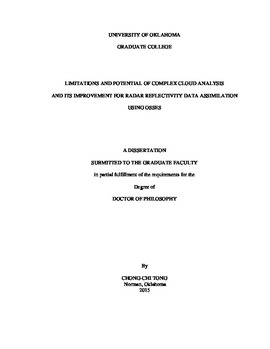| dc.description.abstract | The radar data assimilation is very important for improving short-range precipitation forecasts. Within the three dimensional variational (3DVAR) framework which is still the prevailing method used for operational regional and convective-scale numerical weather prediction (NWP) systems, complex cloud analysis schemes have been shown to be quite effective for assimilating radar reflectivity data. However, due to semi-empirical nature of such schemes, there exist deficiencies. This study attempts to gain a better understanding of the limitations of the complex cloud analysis system within the Advanced Regional Prediction System (ARPS), and based on the results propose improvements to the system. The sensitivity of the short-range precipitation forecast to the accuracy of the initial state variables is also investigated to guide improvements to the cloud analysis.
A general overview of various existing cloud analysis systems/algorithms is first provided, followed by a detailed introduction to the current version of the ARPS complex cloud analysis system. A new version of the hydrometeor analysis is implemented based on the recently developed reflectivity operators that include a simple melting model. A hydrometeor classification algorithm based on polarimetric radar variables is utilized to help determine the hydrometeor species. The impact of the revised cloud analysis on very short range rainfall forecast is examined for a maritime mesoscale convective vortex case. Only a small sensitivity of the results to this revised cloud analysis algorithm is found. Significant model error is likely to be a contributing factor.
To unambiguously determine the sensitivity of model forecasts to the cloud analysis procedure and to various treatments within, we focus the rest of our study on experiments conducted in an observing system simulation experiment (OSSE) framework, for a case of mesoscale convective system (MCS) that occurred over central United States. A degraded initial condition is created through smoothing a truth forecast and by removing cloud fields. The simulation based on this degraded initial condition serves as a control, while sensitivity and data assimilation experiments try to improve the degraded initial conditions, or examine the impact of improved initial conditions.
The sensitivity of precipitation forecasts of up to four hours to 1) model error due to the use of different microphysics scheme and 2) accuracy of model initial state variables is first investigated. The sensitivity to state variables is examined by inserting the perfect values of individual or a group of variables back into the smoothed initial conditions. The forecast winds, temperature (T), moisture (qv), total water-ice mixing ratio (qw), and radar reflectivity (Z) of sensitivity experiments are evaluated in terms of the root mean square (RMS) error calculated against the truth. The results show that compared to the initial state of hydrometeors, the model microphysics has a relatively small impact on the prediction of state variables in a relatively short range. However, microphysics errors become significant for longer range forecasts, such after two hours, when evaluated in terms of forecast reflectivity. Among the model state variables updated by the cloud analysis, qv is found to have the greatest impact on the prediction of state variables and forecast reflectivity. Precipitation hydrometeors have the second largest impact in terms of short-term prediction of qw and associated T while the importance of the non-precipitating hydrometeors is relatively small.
The other set of experiments is designed to examine the impact and effectiveness of the cloud analysis scheme. In these experiments, hydrometeor and associated in-cloud state variables in the initial condition are obtained using the ARPS cloud analysis scheme with varying configurations, rather than through direct insertion as in the first set of experiments. When performing the hydrometeor analysis only without updating any other in-cloud state variable, noticeable and up-to-four-hours positive impact on forecast can be found in comparison with the hydrometeor-clear control. However, when qv is adjusted to the value of saturation mixing ratio, i.e., the relative humidity (RH) is adjusted to 100% within precipitation region, as is done in the current ARPS cloud analysis procedure, rapid forecast error growth is found in most state variables and reflectivity is significantly over-forecasted. The in-cloud temperature adjustment towards the moist-adiabat of low-level lifted parcel in the cloud analysis is found to work quite well.
Based on the results of the earlier OSSEs, efforts are made to improve the qv adjustment procedure in the cloud analysis to reduce precipitation overforecast. The effectiveness of a better specified in-cloud humidity field, by direct insertion of the true RH, is firstly demonstrated. A modified qv adjustment procedure making use of the vertical velocity information is further proposed. This procedure avoids over-moistening in the downdraft regions, but the overall error in the adjusted qv is not necessarily reduced quantitatively due to loose relationship between vertical velocity and relative humidity. Still, the forecasts resulting from the modified qv adjustment is significantly improved over that from the original scheme. | en_US |
